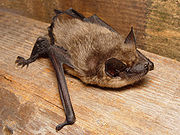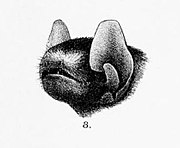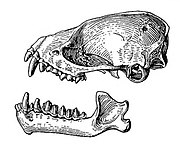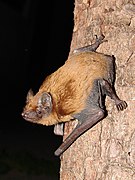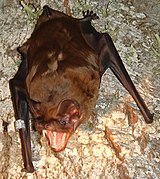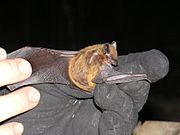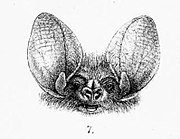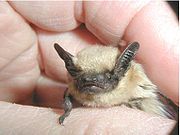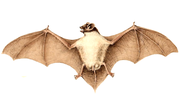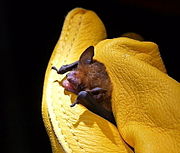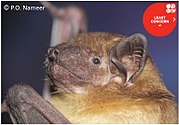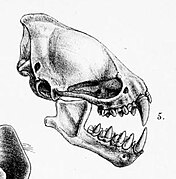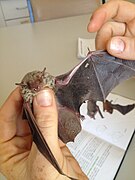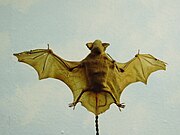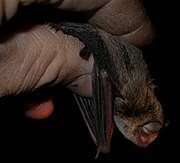Subfamily Vespertilioninae
| Common name | Scientific name and subspecies | Range | Size and ecology | IUCN status and estimated population |
|---|---|---|---|---|
| Pallid bat | A. pallidus (LeConte, 1856) Seven subspecies
|
Western North America and Cuba
|
Size: UNKNOWN LENGTH SEEN: 60–85 cm (24–33 in) Habitat: Forest, rocky areas, and caves Diet: VERIFY ME: Their own |
LC
|
| Common name | Scientific name and subspecies | Range | Size and ecology | IUCN status and estimated population |
|---|---|---|---|---|
| Bronze sprite | A. circumdatus (Temminck, 1840) |
Southeastern Asia
|
Size: Habitat: Forest Diet: VERIFY POSSIBLE FOOD: Insectivorous |
LC
|
| Coppery sprite
|
A. cuprosus Hill & Francis, 1984 |
Malaysia
|
Size: Habitat: Forest Diet: |
VU
|
| Necklace sprite
|
A. torquatus (Csorba & Lee, 1999) |
Taiwan
|
Size: Habitat: Forest and inland wetlands Diet: |
LC
|
| Social sprite
|
A. societatis Hill, 1972 |
Malay Peninsula
|
Size: Habitat: Forest Diet: |
LC
|
| Common name | Scientific name and subspecies | Range | Size and ecology | IUCN status and estimated population |
|---|---|---|---|---|
| Allen's yellow bat
|
B. alleni Thomas, 1892 |
Southern Mexico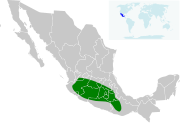
|
Size: Habitat: Forest Diet: VERIFY POSSIBLE FOOD: Insectivorous |
LC
|
| Slender yellow bat
|
B. gracilis Miller, 1897 |
Southern Mexico
|
Size: Habitat: Forest Diet: |
LC
|
| Common name | Scientific name and subspecies | Range | Size and ecology | IUCN status and estimated population |
|---|---|---|---|---|
| Van Gelder's bat | B. dubiaquercus Van Gelder, 1959 |
Southern Mexico and Central America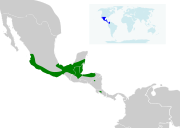
|
Size: Habitat: Forest Diet: VERIFY POSSIBLE FOOD: Insects |
NT
|
| Common name | Scientific name and subspecies | Range | Size and ecology | IUCN status and estimated population |
|---|---|---|---|---|
| Anatolian serotine bat
|
E. anatolicus Felten, 1971 |
Size: Habitat: Forest and shrubland Diet: VERIFY ME: A range of insects |
LC
| |
| Argentine brown bat | E. furinalis d'Orbigny & Gervais, 1847 Four subspecies
|
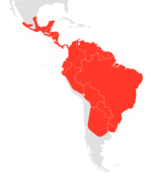
|
Size: Habitat: Forest Diet: |
LC
|
| Big brown bat | E. fuscus (Palisot de Beauvois, 1796) Twelve subspecies
|

|
Size: VERIFY ME: long, plus 3–5 cm (1–2 in) tail Habitat: Forest, rocky areas, and caves Diet: VERIFY POSSIBLE FOOD: InsectsVERIFY POSSIBLE FOOD: Insects |
LC
|
| Bobrinski's serotine
|
E. bobrinskoi Kuzyakin, 1935 |
Size: Habitat: Desert Diet: |
DD
| |
| Botta's serotine
|
E. bottae (Peters, 1869) Seven subspecies
|
Size: Habitat: 26% Diet: |
Please add parameter
| |
| Brazilian brown bat | E. brasiliensis Desmarest, 1819 Four subspecies
|

|
Size: Habitat: Forest Diet: VERIFY POSSIBLE FOOD: Insectivores |
LC
|
| Chiriquinan serotine
|
E. chiriquinus Thomas, 1920 |

|
Size: Habitat: Forest Diet: VERIFY POSSIBLE FOOD: Insectivorous |
LC
|
| Diminutive serotine | E. diminutus Osgood, 1915 Two subspecies
|
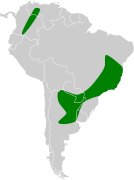
|
Size: Habitat: Forest Diet: VERIFY POSSIBLE FOOD: Insectivorous |
LC
|
| Gobi big brown bat
|
E. gobiensis Bóbrinski, 1926 Three subspecies
|
Size: Habitat: Shrubland, grassland, and desert Diet: |
LC
| |
| Guadeloupe big brown bat
|
E. guadeloupensis Genoways & Baker, 1975 |
Size: Habitat: Forest Diet: VERIFY POSSIBLE FOOD: Insectivorous |
EN
| |
| Harmless serotine
|
E. innoxius (Gervais, 1841) |

|
Size: Habitat: Forest Diet: VERIFY POSSIBLE FOOD: Insectivorous |
NT
|
| Horn-skinned bat
|
E. floweri De Winton, 1901 |

|
Size: Habitat: Desert, grassland, and shrubland Diet: |
LC
|
| Japanese short-tailed bat
|
E. japonensis Imaizumi, 1953 |
Size: Habitat: Forest Diet: |
VU
| |
| Kobayashi's bat
|
E. kobayashii (Mori, 1928) |

|
Size: Habitat: Unknown Diet: |
DD
|
| Lagos serotine
|
E. platyops Thomas, 1901 |
Size: Habitat: Unknown Diet: |
DD
| |
| Little black serotine
|
E. andinus (Allen, 1914) |
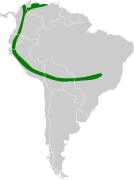
|
Size: Habitat: Unknown Diet: VERIFY POSSIBLE FOOD: Insectivorous |
LC
|
| Long-tailed house bat
|
E. hottentotus Smith, 1833 Three subspecies
|
Size: Habitat: Rocky areas, inland wetlands, grassland, shrubland, savanna, and forest Diet: |
LC
| |
| Meridional serotine | E. isabellinus Temminck, 1840 |

|
Size: Habitat: Forest, shrubland, and grassland Diet: |
LC
|
| Northern bat | E. nilssonii (Keyserling & Blasius, 1839) Two subspecies
|

|
Size: Habitat: Forest, inland wetlands, caves, and desert Diet: VERIFY POSSIBLE FOOD: Insects |
LC
|
| Ognev's serotine
|
E. ognevi Bóbrinski, 1918 |
Size: Habitat: Shrubland, rocky areas, and desert Diet: |
LC
| |
| Oriental serotine | E. pachyomus Tomes, 1857 |

|
Size: Habitat: Forest, shrubland, and caves Diet: |
LC
|
| Serotine bat | E. serotinus (Schreber, 1774) Ten subspecies
|

|
Size: UNKNOWN LENGTH SEEN: 62–80 cm (24–31 in) Habitat: Forest, savanna, shrubland, grassland, inland wetlands, rocky areas, and caves Diet: VERIFY POSSIBLE FOOD: InsectsVERIFY ME: For insects such as farmland, open grassy meadows, on the edge of forests, and around streetlights |
LC
|
| Sind bat
|
E. nasutus (Dobson, 1877) Four subspecies
|
Size: Habitat: Forest, savanna, caves, and desert Diet: |
LC
| |
| Sombre bat
|
E. tatei Ellerman & Morrison-Scott, 1951 |
Size: Habitat: Forest Diet: |
DD
| |
| Surat helmeted bat
|
E. dimissus (Thomas, 1916) |

|
Size: Habitat: Unknown Diet: |
DD
|
| Taddei's serotine | E. taddeii Miranda, Bernardi, & Passos, 2006 |
Size: Habitat: Forest Diet: |
DD
| |
| Thick-eared bat
|
E. pachyotis Dobson, 1871 |

|
Size: Habitat: Forest Diet: |
LC
|
| Common name | Scientific name and subspecies | Range | Size and ecology | IUCN status and estimated population |
|---|---|---|---|---|
| Common thick-thumbed bat | G. tylopus (Dobson, 1875) Two subspecies
|

|
Size: Habitat: Forest Diet: VERIFY POSSIBLE FOOD: Leaves |
LC
|
| Indochinese thick-thumbed bat
|
G. bucephalus Csorba, 2011 |
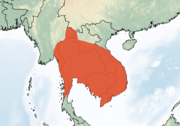
|
Size: Habitat: Forest Diet: |
LC
|
| Javan thick-thumbed bat
|
G. javanus Chasen, 1939 |
Size: Habitat: Forest Diet: |
DD
|
| Common name | Scientific name and subspecies | Range | Size and ecology | IUCN status and estimated population |
|---|---|---|---|---|
| Blanford's bat
|
H. blanfordi Dobson, 1877 |

|
Size: Habitat: Forest and caves Diet: |
LC
|
| False serotine bat
|
H. doriae (Peters, 1868) |
Size: Habitat: Forest Diet: VERIFY POSSIBLE FOOD: Leaves |
DD
| |
| Gaskell's false serotine
|
H. gaskelli Hill, 1983 |

|
Size: Habitat: Forest Diet: VERIFY POSSIBLE FOOD: Insectivorous |
DD
|
| Large false serotine
|
H. tomesi Thomas, 1905 |

|
Size: Habitat: Forest Diet: |
VU
|
| Tickell's bat | H. tickelli Blyth, 1851 |

|
Size: Habitat: Forest and caves Diet: VERIFY ME: Beetles, termites and other insects |
LC
|
| Common name | Scientific name and subspecies | Range | Size and ecology | IUCN status and estimated population |
|---|---|---|---|---|
| Big red bat
|
L. egregius (Peters, 1870) |

|
Size: Habitat: Forest Diet: |
DD
|
| Cinnamon red bat | L. varius (Poeppig, 1835) |

|
Size: Habitat: Forest Diet: VERIFY ME: Insects, mostly homoptera, coleoptera, hymenoptera and diptera (mann 1978) |
LC
|
| Eastern red bat | L. borealis O. F. Müller, 1776 |

|
Size: UNKNOWN LENGTH SEEN: 93–117 cm (37–46 in) Habitat: Forest Diet: VERIFY ME: On their own (myers and hatchett 2000)VERIFY ME: On their own |
LC
|
| Greater red bat
|
L. atratus Handley, 1996 |
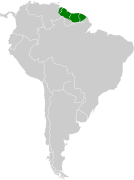
|
Size: Habitat: Forest Diet: VERIFY POSSIBLE FOOD: Insects |
LC
|
| Hairy-tailed bat
|
L. ebenus Fazzolari-Corrêa, 1994 |
Size: Habitat: Forest Diet: |
DD
| |
| Hoary bat | L. cinereus (Palisot de Beauvois, 1796) Three subspecies
|
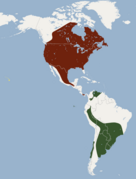
|
Size: UNKNOWN LENGTH SEEN: 13–15 cm (5–6 in) Habitat: Forest and caves Diet: VERIFY ME: About the tree tops, along streams and lake shores, and in urban areas where there are lots of treesVERIFY ME: About the tree tops, along streams and lake shores, and in urban areas where there are lots of trees |
LC
|
| Jamaican red bat
|
L. degelidus Miller, 1931 |
Size: Habitat: Forest Diet: VERIFY POSSIBLE FOOD: Insectivorous |
VU
| |
| Minor red bat
|
L. minor Miller, 1931 |
Size: Habitat: Forest Diet: VERIFY POSSIBLE FOOD: Leaves |
VU
| |
| Northern yellow bat | L. intermedius (H. Allen, 1862) Two subspecies
|

|
Size: UNKNOWN LENGTH SEEN: 3–4 cm (1–2 in) Habitat: Forest Diet: VERIFY POSSIBLE FOOD: LeavesVERIFY POSSIBLE FOOD: Insects |
LC
|
| Pfeiffer's red bat
|
L. pfeifferi Gundlach, 1861 |
Size: Habitat: Unknown Diet: VERIFY POSSIBLE FOOD: Insectivorous |
NT
| |
| Saline red bat | L. salinae (Thomas, 1902) |
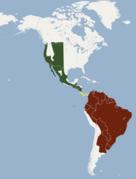
|
Size: Habitat: Shrubland Diet: |
DD
|
| Seminole bat | L. seminolus (Rhoads, 1895) |
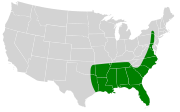
|
Size: UNKNOWN LENGTH SEEN: 1,958–1,966 cm (771–774 in) Habitat: Forest Diet: VERIFY POSSIBLE FOOD: InsectsVERIFY POSSIBLE FOOD: Leaves |
LC
|
| Southern red bat | L. blossevillii (Lesson & Garnot, 1826) Four subspecies
|

|
Size: UNKNOWN LENGTH SEEN: 35–45 cm (14–18 in) Habitat: Forest and savanna Diet: VERIFY POSSIBLE FOOD: InsectivorousVERIFY POSSIBLE FOOD: Fruit |
LC
|
| Southern yellow bat | L. ega Gervais, 1856 Five subspecies
|

|
Size: UNKNOWN LENGTH SEEN: 80–90 cm (31–35 in) Habitat: Forest Diet: VERIFY POSSIBLE FOOD: Insects |
LC
|
| Tacarcuna bat
|
L. castaneus Handley, 1960 |
Size: Habitat: Forest Diet: |
DD
| |
| Western yellow bat | L. xanthinus Thomas, 1897 |

|
Size: UNKNOWN LENGTH SEEN: 33.5–35.5 cm (13–14 in) Habitat: Forest and savanna Diet: VERIFY POSSIBLE FOOD: InsectivorousVERIFY ME: Above them |
LC
|
| Common name | Scientific name and subspecies | Range | Size and ecology | IUCN status and estimated population |
|---|---|---|---|---|
| Azores noctule | N. azoreum Thomas, 1901 |
Size: Habitat: Forest and inland wetlands Diet: VERIFY ME: Unavailable |
VU
| |
| Birdlike noctule
|
N. aviator Thomas, 1911 |

|
Size: Habitat: Forest Diet: VERIFY ME: Coleoptera, lepidoptera, trichoptera, ephemeroptera and hemiptera (fukui et al |
NT
|
| Chinese noctule | N. plancyi Gerbe, 1880 Two subspecies
|

|
Size: Habitat: Forest, rocky areas, and caves Diet: |
LC
|
| Common noctule | N. noctula (Schreber, 1774) Four subspecies
|

|
Size: VERIFY ME: 5–10 cm (2–4 in) long, plus 3–7 cm (1–3 in) tail Habitat: Caves, inland wetlands, and forest Diet: VERIFY POSSIBLE FOOD: InsectivoresVERIFY ME: In open areas and dwell in or near human habitation |
LC
|
| Greater noctule bat | N. lasiopterus (Schreber, 1780) |

|
Size: Habitat: Forest and shrubland Diet: VERIFY POSSIBLE FOOD: Insectivorous |
VU
|
| Japanese noctule
|
N. furvus Imaizumi & Yoshiyuki, 1968 |
Size: Habitat: Forest Diet: |
EN
| |
| Lesser noctule | N. leisleri (Kuhl, 1817) Two subspecies
|
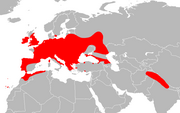
|
Size: UNKNOWN LENGTH SEEN: 260–320 cm (102–126 in) Habitat: Forest, shrubland, and rocky areas Diet: VERIFY ME: Flies (including mosquitos), moths and beetlesVERIFY ME: Over many adjacent types of habitat including fields and open water |
LC
|
| Mountain noctule
|
N. montanus Barrett-Hamilton, 1906 |
Size: Habitat: Forest, rocky areas, and caves Diet: |
LC
|
| Common name | Scientific name and subspecies | Range | Size and ecology | IUCN status and estimated population |
|---|---|---|---|---|
| Schlieffen's serotine | N. schlieffeni (Peters, 1869) |
Size: Habitat: Savanna, shrubland, and desert Diet: |
LC
|
| Common name | Scientific name and subspecies | Range | Size and ecology | IUCN status and estimated population |
|---|---|---|---|---|
| Cuban evening bat
|
N. cubanus Gundlach, 1861 |
Size: Habitat: Unknown Diet: VERIFY POSSIBLE FOOD: Insectivorous |
NT
| |
| Evening bat | N. humeralis (Rafinesque, 1818) Three subspecies
|

|
Size: VERIFY ME: 8–11 cm (3–4 in) long, plus 3–5 cm (1–2 in) tail Habitat: Forest Diet: VERIFY POSSIBLE FOOD: Insects |
LC
|
| Temminck's mysterious bat
|
N. aenobarbus Temminck, 1840 |
Size: Habitat: Diet: |
DD
|
| Common name | Scientific name and subspecies | Range | Size and ecology | IUCN status and estimated population |
|---|---|---|---|---|
| Arnhem long-eared bat
|
N. arnhemensis Johnson, 1959 |

|
Size: Habitat: Forest and savanna Diet: |
LC
|
| Eastern long-eared bat | N. bifax Thomas, 1915 Two subspecies
|
Size: Habitat: Forest and inland wetlands Diet: |
LC
| |
| Gould's long-eared bat | N. gouldi Tomes, 1858 |
Size: Habitat: Forest Diet: VERIFY ME: In dense vegetation |
LC
| |
| Greater long-eared bat
|
N. timoriensis Geoffroy, 1806 Three subspecies
|
Size: Habitat: Forest Diet: |
DD
| |
| Holts' long-eared bat
|
N. holtorum Parnaby, King, & Eldridge, 2021 |
Size: Habitat: Forest Diet: VERIFY ME: Within the forests, rather than in the open against vegetation |
LC
| |
| Lesser long-eared bat | N. geoffroyi Leach, 1821 Three subspecies
|
Size: UNKNOWN LENGTH SEEN: 30–40 cm (12–16 in) Habitat: Forest, savanna, shrubland, and grassland Diet: VERIFY ME: Moths, crickets, grasshoppers and beetles (lumsden and turbill 2008)VERIFY POSSIBLE FOOD: Insects |
LC
| |
| Lord Howe long-eared bat
|
N. howensis McKean, 1975 |

|
Size: Habitat: Unknown Diet: |
EX
|
| Mount Missim long-eared bat
|
N. shirleyae Parnaby, 2009 |

|
Size: Habitat: Forest Diet: |
DD
|
| New Caledonian long-eared bat
|
N. nebulosus Parnaby, 2002. |
Size: Habitat: Forest Diet: VERIFY POSSIBLE FOOD: Insectivores |
CR
| |
| New Guinea long-eared bat
|
N. microtis Thomas, 1888 |

|
Size: Habitat: Forest and caves Diet: |
LC
|
| Pallid long-eared bat
|
N. daedalus Thomas, 1915 |
Size: Habitat: Forest and inland wetlands Diet: VERIFY POSSIBLE FOOD: Insects |
LC
| |
| Pygmy long-eared bat
|
N. walkeri Thomas, 1892 |
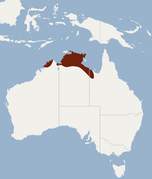
|
Size: Habitat: Forest and savanna Diet: |
LC
|
| Small-toothed long-eared bat
|
N. microdon Laurie & Hill, 1954 |

|
Size: Habitat: Caves Diet: VERIFY POSSIBLE FOOD: Insects |
LC
|
| Southeastern long-eared bat | N. corbeni Parnaby, 2009 |
Size: Habitat: Forest Diet: VERIFY ME: In the woodlands of private land in new south wales and queensland are also a likely threat (schulz and lumsden 2010) |
VU
| |
| Sunda long-eared bat
|
N. heran Kitchener, How, & Maharadatunkamsi, 1991 |
Size: Habitat: Forest Diet: |
DD
| |
| Tasmanian long-eared bat
|
N. sherrini Thomas, 1915 |
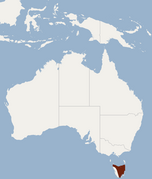
|
Size: Habitat: Forest Diet: VERIFY POSSIBLE FOOD: Insects |
VU
|
| Western long-eared bat | N. major Gray, 1844 |
Size: Habitat: Forest Diet: VERIFY POSSIBLE FOOD: Insects |
LC
|
| Common name | Scientific name and subspecies | Range | Size and ecology | IUCN status and estimated population |
|---|---|---|---|---|
| Canyon bat | P. hesperus (H. Allen, 1864) |
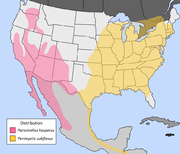
|
Size: Habitat: Forest, grassland, rocky areas, caves, and desert Diet: |
LC
|
| Common name | Scientific name and subspecies | Range | Size and ecology | IUCN status and estimated population |
|---|---|---|---|---|
| Tricolored bat | P. subflavus (F. Cuvier, 1832) Four subspecies
|

|
Size: Habitat: Forest, rocky areas, and caves Diet: VERIFY ME: Composed of coleoptera, homoptera, diptera, hymenoptera and lepidoptera (fujita and kunz 1984) |
VU
|
| Common name | Scientific name and subspecies | Range | Size and ecology | IUCN status and estimated population |
|---|---|---|---|---|
| New Guinea big-eared bat
|
P. imogene Thomas, 1914 |

|
Size: Habitat: Forest Diet: VERIFY POSSIBLE FOOD: Insects |
CR
|
| Common name | Scientific name and subspecies | Range | Size and ecology | IUCN status and estimated population |
|---|---|---|---|---|
| Rüppell's bat | P. rueppellii J. B. Fischer, 1829 Six subspecies
|
Size: Habitat: Desert, shrubland, and savanna Diet: |
LC
| |
| Aellen's pipistrelle
|
P. inexspectatus Aellen, 1959 |
Size: Habitat: Forest and savanna Diet: |
DD
| |
| Angulate pipistrelle
|
P. angulatus Peters, 1880 Two subspecies
|
Size: Habitat: Forest and caves Diet: VERIFY ME: On aerial insects |
LC
| |
| Broad-headed serotine
|
P. crassulus (Thomas, 1904) |
Size: Habitat: Forest Diet: |
LC
| |
| Christmas Island pipistrelle
|
P. murrayi (Andrews, 1900) |
Size: Habitat: Forest Diet: |
EX
| |
| Common pipistrelle | P. pipistrellus (Schreber, 1774) Two subspecies
|
Size: UNKNOWN LENGTH SEEN: 180–240 cm (71–94 in) Habitat: Forest, shrubland, inland wetlands, and caves Diet: VERIFY ME: Small moths and fliesVERIFY ME: Mosquitos, small moths and other insects |
LC
| |
| Dar es Salaam pipistrelle
|
P. permixtus Aellen, 1957 |
Size: Habitat: Forest Diet: |
DD
| |
| Dobson's pipistrelle
|
P. grandidieri (Dobson, 1876) |
Size: Habitat: Forest, savanna, and inland wetlands Diet: |
DD
| |
| Dusky pipistrelle
|
P. hesperidus (Temminck, 1840) Three subspecies
|

|
Size: Habitat: Forest and savanna Diet: |
LC
|
| Endo's pipistrelle
|
P. endoi Imaizumi, 1959 |

|
Size: Habitat: Forest and other Diet: |
NT
|
| Forest pipistrelle
|
P. adamsi Kitchener, Caputi, & Jones, 1986 |

|
Size: Habitat: Savanna and forest Diet: |
LC
|
| Greater Papuan pipistrelle
|
P. collinus Thomas, 1920 |
Size: Habitat: Forest Diet: |
LC
| |
| Hanak's pipistrelle
|
P. hanaki Hulva & Benda, 2004 |
Size: Habitat: Forest, shrubland, inland wetlands, and rocky areas Diet: |
VU
| |
| Indian pipistrelle | P. coromandra Gray, 1838 |

|
Size: Habitat: Forest and caves Diet: VERIFY POSSIBLE FOOD: Insects |
LC
|
| Japanese house bat | P. abramus (Temminck, 1840) |

|
Size: Habitat: Forest, grassland, inland wetlands, and intertidal marine Diet: VERIFY POSSIBLE FOOD: Insects |
LC
|
| Java pipistrelle
|
P. javanicus Gray, 1838 Five subspecies
|

|
Size: Habitat: Caves and forest Diet: VERIFY POSSIBLE FOOD: Insects |
LC
|
| Kelaart's pipistrelle
|
P. ceylonicus Kelaart, 1852 Seven subspecies
|
Size: Habitat: Forest and caves Diet: VERIFY POSSIBLE FOOD: Insects |
LC
| |
| Kuhl's pipistrelle | P. kuhlii Kuhl, 1817 Three subspecies
|

|
Size: Habitat: Forest, shrubland, and grassland Diet: VERIFY ME: Small insects, including diptera, psocoptera, and coleoptera |
LC
|
| Least pipistrelle | P. tenuis (Temminck, 1840) Eight subspecies
|
Size: UNKNOWN LENGTH SEEN: 69–77 cm (27–30 in) Habitat: Forest, shrubland, and grassland Diet: VERIFY ME: Beetles, cockroaches and wingless ants in winter, on a wide variety of insects in summer and on winter termites, moths, hymenopterans, dipterans and beetles during monsoonVERIFY ME: For insects |
LC
| |
| Lesser Papuan pipistrelle
|
P. papuanus Peters & Doria, 1881 |
Size: Habitat: Forest Diet: VERIFY ME: In urban areas and plantations |
LC
| |
| Madeira pipistrelle
|
P. maderensis Dobson, 1878 |

|
Size: Habitat: Forest and inland wetlands Diet: |
EN
|
| Minahassa pipistrelle
|
P. minahassae von Meyer, 1899 |
Size: Habitat: Unknown Diet: |
DD
| |
| Mount Gargues pipistrelle
|
P. aero Heller, 1912 |
Size: Habitat: Forest Diet: |
DD
| |
| Mount Popa pipistrelle
|
P. paterculus Thomas, 1915 Two subspecies
|

|
Size: Habitat: Forest Diet: VERIFY POSSIBLE FOOD: Insectivorous |
LC
|
| Narrow-winged pipistrelle | P. stenopterus Dobson, 1875 |
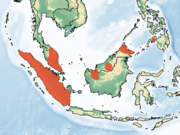
|
Size: Habitat: Forest, shrubland, grassland, and inland wetlands Diet: |
LC
|
| Nathusius's pipistrelle | P. nathusii (Keyserling & Blasius, 1839) |
Size: Habitat: Forest and inland wetlands Diet: VERIFY POSSIBLE FOOD: Insectivorous |
LC
| |
| Northern pipistrelle
|
P. westralis Koopman, 1984 |

|
Size: Habitat: Forest Diet: |
LC
|
| Racey's pipistrelle
|
P. raceyi Bates, Ratrimomanarivo, Harrison, & Goodman, 2006 |

|
Size: Habitat: Forest Diet: |
DD
|
| Rusty pipistrelle
|
P. rusticus (Tomes, 1861) Two subspecies
|
Size: Habitat: Forest and savanna Diet: |
LC
| |
| Soprano pipistrelle | P. pygmaeus (Leach, 1825) |

|
Size: Habitat: Forest and inland wetlands Diet: |
LC
|
| Sturdee's pipistrelle
|
P. sturdeei Thomas, 1915 |
Size: Habitat: Unknown Diet: |
EX
| |
| Tiny pipistrelle
|
P. nanulus Thomas, 1904 |
Size: Habitat: Forest and savanna Diet: |
LC
| |
| Watts's pipistrelle
|
P. wattsi Kitchener, Caputi, & Jones, 1986 |
Size: Habitat: Forest Diet: VERIFY ME: In urban areas (where it has most frequently been captured) (burgin 2019, bonaccorso 1998) |
LC
|
| Common name | Scientific name and subspecies | Range | Size and ecology | IUCN status and estimated population |
|---|---|---|---|---|
| Bickham's little yellow bat
|
R. bickhami Baird, Marchán-Rivadeneira, Pérez, & Baker, 2012 |

|
Size: Habitat: Forest Diet: |
LC
|
| Black-winged little yellow bat | R. tumida H. Allen, 1866 |

|
Size: Habitat: Forest Diet: VERIFY ME: Small flying insects, and individuals appear to have established hunting routes |
LC
|
| Ecuadorian little yellow bat
|
R. velilla Thomas, 1903 |
Size: Habitat: Forest Diet: VERIFY POSSIBLE FOOD: Insectivorous |
DD
| |
| Genoways's yellow bat | R. genowaysi Baker, 1984 |

|
Size: Habitat: Forest Diet: |
EN
|
| Husson's yellow bat
|
R. hussoni Genoways & Baker, 1996 |

|
Size: Habitat: Forest Diet: |
DD
|
| Least yellow bat
|
R. mira LaVal, 1973 |

|
Size: Habitat: Forest Diet: |
VU
|
| Little yellow bat | R. parvula H. Allen, 1866 |

|
Size: Habitat: Forest Diet: VERIFY POSSIBLE FOOD: Insectivorous |
LC
|
| Menchu's little yellow bat
|
R. menchuae Baird, Marchán-Rivadeneira, Pérez, & Baker, 2012 |

|
Size: Habitat: Forest Diet: |
DD
|
| Thomas's yellow bat | R. io Thomas, 1903 |

|
Size: Habitat: Forest Diet: VERIFY ME: Small flying insects |
LC
|
| Tiny yellow bat
|
R. minutilla Miller, 1897 |

|
Size: Habitat: Forest and shrubland Diet: VERIFY ME: Small aerial insects that it catches in open areas, including diptera, hymenoptera, lepidoptera and coleoptera (sosa et al |
VU
|
| Yucatan yellow bat | R. aeneus Goodwin, 1958 |

|
Size: Habitat: Forest Diet: VERIFY ME: In relatively cluttered situations (audet et al |
LC
|
| Common name | Scientific name and subspecies | Range | Size and ecology | IUCN status and estimated population |
|---|---|---|---|---|
| Rüppell's broad-nosed bat | S. rueppellii (Peters, 1866) |

|
Size: Habitat: Forest Diet: |
LC
|
| Common name | Scientific name and subspecies | Range | Size and ecology | IUCN status and estimated population |
|---|---|---|---|---|
| Dark-winged lesser house bat
|
S. hirundo De Winton, 1899 |
Size: Habitat: Savanna and forest Diet: |
LC
| |
| Desert yellow bat
|
S. pallidus Dobson, 1876 |
Size: Habitat: Forest and shrubland Diet: |
LC
| |
| Hinde's lesser house bat
|
S. hindei Thomas, 1901 Two subspecies
|
Size: Habitat: Savanna and forest Diet: |
LC
| |
| Light-winged lesser house bat
|
S. albofuscus Thomas, 1890 Two subspecies
|
Size: Habitat: Forest and savanna Diet: |
DD
| |
| White-bellied lesser house bat
|
S. albigula Thomas, 1909 |
Size: Habitat: Forest and savanna Diet: |
LC
|
| Common name | Scientific name and subspecies | Range | Size and ecology | IUCN status and estimated population |
|---|---|---|---|---|
| Harlequin bat | S. ornatus (Blyth, 1851) Three subspecies
|

|
Size: Habitat: Forest and caves Diet: VERIFY ME: For food around bodies of water (eger 2002 |
LC
|
| Common name | Scientific name and subspecies | Range | Size and ecology | IUCN status and estimated population |
|---|---|---|---|---|
| African yellow bat | S. dinganii A. Smith, 1833 Four subspecies
|
Size: Habitat: Savanna Diet: |
LC
| |
| Andrew Rebori's house bat
|
S. andrewreborii Brooks & Bickham, 2014 |

|
Size: Habitat: Forest and savanna Diet: |
LC
|
| Eastern greenish yellow bat | S. viridis (Peters, 1852) Two subspecies
|
Size: Habitat: Savanna Diet: |
LC
| |
| Ejeta's yellow bat
|
S. ejetai Brooks & Bickham, 2014 |
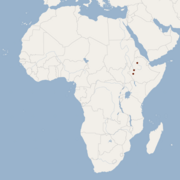
|
Size: Habitat: Grassland, shrubland, and savanna Diet: |
LC
|
| Greater Asiatic yellow bat | S. heathii Horsfield, 1831 Three subspecies
|

|
Size: Habitat: Forest, shrubland, and desert Diet: VERIFY POSSIBLE FOOD: Leaves |
LC
|
| Lesser Asiatic yellow bat | S. kuhlii Leach, 1821 Seven subspecies
|

|
Size: Habitat: Forest, shrubland, and desert Diet: VERIFY ME: Hymenopterans and dipterans |
LC
|
| Lesser yellow bat | S. borbonicus Geoffroy, 1803 |

|
Size: Habitat: Unknown Diet: |
DD
|
| Malagasy yellow bat
|
S. tandrefana Goodman, Jenkin, & Ratrimomanarivo, 2005 |

|
Size: Habitat: Forest Diet: |
DD
|
| Nut-colored yellow bat
|
S. nux Thomas, 1904 |
Size: Habitat: Forest Diet: |
LC
| |
| Robbins's yellow bat
|
S. nucella Robbins, 1984 |
Size: Habitat: Forest Diet: |
DD
| |
| Robust yellow bat | S. robustus H. Milne-Edwards, 1881 |

|
Size: Habitat: Forest Diet: |
LC
|
| Schreber's yellow bat | S. nigrita (Schreber, 1774) Two subspecies
|
Size: Habitat: Forest and savanna Diet: |
LC
| |
| Sody's yellow bat | S. collinus Sody, 1936 |
Size: Habitat: Forest Diet: |
LC
| |
| Sulawesi yellow bat
|
S. celebensis (Sody, 1928) |
Size: Habitat: Forest Diet: VERIFY ME: In open areas, above the canopy |
DD
| |
| Trujillo's yellow bat
|
S. trujilloi Brooks & Bickham, 2014 |

|
Size: Habitat: Forest Diet: |
LC
|
| White-bellied yellow bat | S. leucogaster Cretzschmar, 1826 Two subspecies
|
Size: Habitat: Savanna Diet: |
LC
|
| Common name | Scientific name and subspecies | Range | Size and ecology | IUCN status and estimated population |
|---|---|---|---|---|
| Eastern broad-nosed bat
|
S. orion (Troughton, 1937) |
Size: Habitat: Forest Diet: |
LC
| |
| Inland broad-nosed bat | S. balstoni (Thomas, 1906) Two subspecies
|

|
Size: Habitat: Forest, savanna, shrubland, and desert Diet: VERIFY ME: A range of flying insects, with coleoptera, hymenoptera and hemiptera often commonly taken (lumsden and bennett 1995) |
LC
|
| Little broad-nosed bat | S. greyii Gray, 1842 |
Size: Habitat: Desert, grassland, shrubland, savanna, and forest Diet: VERIFY POSSIBLE FOOD: Insectivorous |
LC
| |
| Northern broad-nosed bat
|
S. sanborni (Troughton, 1937) |

|
Size: Habitat: Forest and savanna Diet: |
LC
|
| Common name | Scientific name and subspecies | Range | Size and ecology | IUCN status and estimated population |
|---|---|---|---|---|
| Dormer's bat
|
S. dormeri Dobson, 1875 |
Size: Habitat: Forest, shrubland, and desert Diet: VERIFY ME: Agriculturally important insect pests (molur et al |
LC
|
| Common name | Scientific name and subspecies | Range | Size and ecology | IUCN status and estimated population |
|---|---|---|---|---|
| Collared sprite
|
T. aureocollaris Kock & Storch, 1996 |
Size: Habitat: Forest Diet: VERIFY POSSIBLE FOOD: Insects |
LC
|
| Common name | Scientific name and subspecies | Range | Size and ecology | IUCN status and estimated population |
|---|---|---|---|---|
| Pygmy bamboo bat
|
T. pygmaea Feng, Li, & Wang, 2008 |

|
Size: Habitat: 26% Diet: |
Please add parameter
|
| Greater bamboo bat | T. robustula Thomas, 1915 Two subspecies
|

|
Size: Habitat: Forest Diet: |
LC
|
| Lesser bamboo bat | T. pachypus (Temminck, 1840) Five subspecies
|

|
Size: UNKNOWN LENGTH SEEN: 12–13 cm (5–5 in) Habitat: Forest Diet: VERIFY ME: 7 different orders of insects |
LC
|
| Common name | Scientific name and subspecies | Range | Size and ecology | IUCN status and estimated population |
|---|---|---|---|---|
| Eastern cave bat | V. troughtoni (Kitchener, Jones, & Caputi, 1987) |
Size: Habitat: Forest and caves Diet: VERIFY ME: Over areas of native vegetation, typically along watercourses (law et al |
LC
| |
| Eastern forest bat | V. pumilus Gray, 1841 |
Size: Habitat: Forest Diet: VERIFY POSSIBLE FOOD: Insectivorous |
LC
| |
| Finlayson's cave bat
|
V. finlaysoni (Kitchener, Jones, & Caputi, 1987) |
Size: Habitat: Forest, savanna, shrubland, grassland, caves, and desert Diet: |
LC
| |
| Inland forest bat
|
V. baverstocki (Kitchener, Jones, & Caputi, 1987) |
Size: Habitat: Savanna, shrubland, and desert Diet: VERIFY POSSIBLE FOOD: Insectivorous |
LC
| |
| Large forest bat
|
V. darlingtoni Allen, 1933 |
Size: Habitat: Forest and grassland Diet: VERIFY POSSIBLE FOOD: Insectivorous |
LC
| |
| Little forest bat | V. vulturnus (Thomas, 1914) |
Size: Habitat: Forest Diet: VERIFY ME: A wide range of small flying insects, including mosquitoes (gonsalves et al |
LC
| |
| Northern cave bat
|
V. caurinus (Thomas, 1914) |
Size: Habitat: Forest, savanna, shrubland, grassland, and caves Diet: |
LC
| |
| Southern forest bat
|
V. regulus (Thomas, 1906) |
Size: Habitat: Forest and shrubland Diet: VERIFY POSSIBLE FOOD: Insects |
LC
| |
| Yellow-lipped bat
|
V. douglasorum (Kitchener, 1976) |
Size: Habitat: Forest, savanna, shrubland, and caves Diet: |
LC
|
| Common name | Scientific name and subspecies | Range | Size and ecology | IUCN status and estimated population |
|---|---|---|---|---|
| Asian particolored bat | V. sinensis Peters, 1880 Five subspecies
|
Size: Habitat: Forest, inland wetlands, rocky areas, caves, desert, and coastal marine Diet: |
LC
| |
| Parti-coloured bat | V. murinus Linnaeus, 1758 Two subspecies
|

|
Size: Habitat: Forest, shrubland, grassland, rocky areas, caves, and desert Diet: VERIFY ME: Moths and beetles |
LC
|
References
- ^ Cite error: The named reference
ADWPallidbatwas invoked but never defined (see the help page). - ^ Arroyo-Cabrales, J.; de Grammont, P. C. (2017). "Antrozous pallidus". IUCN Red List of Threatened Species. 2017: e.T1790A22129152. doi:10.2305/IUCN.UK.2017-2.RLTS.T1790A22129152.en.
- ^ Bates, P.; Bumrungsri, S.; Francis, C.; Csorba, G.; Walston, J.; Molur, S.; Srinivasulu, C.; Kruskop, S. V. (2019). "Arielulus circumdatus". IUCN Red List of Threatened Species. 2019: e.T41534A22005596. doi:10.2305/IUCN.UK.2019-3.RLTS.T41534A22005596.en.
- ^ MacArthur, E. (2016). "Arielulus cuprosus". IUCN Red List of Threatened Species. 2016: e.T40775A22134373. doi:10.2305/IUCN.UK.2016-2.RLTS.T40775A22134373.en.
- ^ Huang, J. C. -C.; Liu, J.-N. (2019). "Arielulus torquatus". IUCN Red List of Threatened Species. 2019: e.T40032A22063510. doi:10.2305/IUCN.UK.2019-3.RLTS.T40032A22063510.en.
- ^ Francis, C. M.; Csorba, G. (2020). "Arielulus societatis". IUCN Red List of Threatened Species. 2020: e.T40776A22134204. doi:10.2305/IUCN.UK.2020-3.RLTS.T40776A22134204.en.
- ^ Solari, S. (2019). "Baeodon alleni". IUCN Red List of Threatened Species. 2019: e.T19679A21989577. doi:10.2305/IUCN.UK.2019-1.RLTS.T19679A21989577.en.
- ^ Parnaby, H. (2020) . "Nyctophilus shirleyae". IUCN Red List of Threatened Species. 2020: e.T85289876A166525572. doi:10.2305/IUCN.UK.2020-1.RLTS.T85289876A166525572.en. Cite error: The named reference "IUCN" was defined multiple times with different content (see the help page).
- ^ Solari, S. (2018). "Bauerus dubiaquercus". IUCN Red List of Threatened Species. 2018: e.T1789A22129523. doi:10.2305/IUCN.UK.2018-2.RLTS.T1789A22129523.en.
- ^ Bouillard, N. (2021). "Eptesicus anatolicus". IUCN Red List of Threatened Species. 2021: e.T85198368A85199537. doi:10.2305/IUCN.UK.2021-1.RLTS.T85198368A85199537.en.
- ^ Barquez, R.; Perez, S.; Miller, B.; Diaz, M. (2016). "Eptesicus furinalis". IUCN Red List of Threatened Species. 2016: e.T7927A22118013. doi:10.2305/IUCN.UK.2016-1.RLTS.T7927A22118013.en.
- ^ Cite error: The named reference
ADWBigbrownbatwas invoked but never defined (see the help page). - ^ Miller, B.; Reid, F.; Arroyo-Cabrales, J.; Cuarón, A. D.; de Grammont, P. C. (2016). "Eptesicus fuscus". IUCN Red List of Threatened Species. 2016: e.T7928A22118197. doi:10.2305/IUCN.UK.2016-3.RLTS.T7928A22118197.en.
- ^ Srinivasulu, C. (2019). "Eptesicus bobrinskoi". IUCN Red List of Threatened Species. 2019: e.T7914A22114842. doi:10.2305/IUCN.UK.2019-3.RLTS.T7914A22114842.en.
- ^ None
- ^ Barquez, R.; Perez, S.; Miller, B.; Diaz, M. (2016). "Eptesicus brasiliensis". IUCN Red List of Threatened Species. 2016: e.T7916A22114459. doi:10.2305/IUCN.UK.2016-1.RLTS.T7916A22114459.en.
- ^ Solari, S. (2019). "Eptesicus chiriquinus". IUCN Red List of Threatened Species. 2019: e.T136524A21981386. doi:10.2305/IUCN.UK.2019-1.RLTS.T136524A21981386.en.
- ^ González, E. M.; Barquez, R. (2017) . "Eptesicus diminutus". IUCN Red List of Threatened Species. 2016: e.T7922A115087028. doi:10.2305/IUCN.UK.2016-3.RLTS.T7922A22118742.en.
- ^ Srinivasulu, C.; Srinivasulu, B. (2019). "Eptesicus gobiensis". IUCN Red List of Threatened Species. 2019: e.T41531A22004381. doi:10.2305/IUCN.UK.2019-3.RLTS.T41531A22004381.en.
- ^ Barataud, M. (2016). "Eptesicus guadeloupensis". IUCN Red List of Threatened Species. 2016: e.T7929A22117922. doi:10.2305/IUCN.UK.2016-1.RLTS.T7929A22117922.en.
- ^ Velazco, P.; Aguirre, L. (2020) . "Eptesicus innoxius". IUCN Red List of Threatened Species. 2020: e.T7932A166506353. doi:10.2305/IUCN.UK.2020-1.RLTS.T7932A166506353.en.
- ^ Monadjem, A.; Fahr, J.; Cotterill, F.; Jacobs, D.; Taylor, P. J. (2017). "Eptesicus floweri". IUCN Red List of Threatened Species. 2017: e.T7926A22118366. doi:10.2305/IUCN.UK.2017-2.RLTS.T7926A22118366.en.
- ^ Fukui, D. (2021) . "Eptesicus japonensis". IUCN Red List of Threatened Species. 2020: e.T136823A209552552. doi:10.2305/IUCN.UK.2020-2.RLTS.T136823A209552552.en.
- ^ Fukui, D. (2019). "Eptesicus kobayashii". IUCN Red List of Threatened Species. 2019: e.T7933A22117423. doi:10.2305/IUCN.UK.2019-3.RLTS.T7933A22117423.en.
- ^ Schlitter, D. (2019). "Eptesicus platyops". IUCN Red List of Threatened Species. 2019: e.T7937A22120759. doi:10.2305/IUCN.UK.2019-3.RLTS.T7937A22120759.en.
- ^ Molinari, J.; Aguirre, L. (2016). "Eptesicus andinus". IUCN Red List of Threatened Species. 2016: e.T7912A22115355. doi:10.2305/IUCN.UK.2016-1.RLTS.T7912A22115355.en.
- ^ Monadjem, A.; Cotterill, F.; Jacobs, D. (2017). "Eptesicus hottentotus". IUCN Red List of Threatened Species. 2017: e.T7931A22117704. doi:10.2305/IUCN.UK.2017-2.RLTS.T7931A22117704.en.
- ^ Juste, J. (2016). "Eptesicus isabellinus". IUCN Red List of Threatened Species. 2016: e.T85200107A85200275. doi:10.2305/IUCN.UK.2016-2.RLTS.T85200107A85200275.en.
- ^ Coroiu, I. (2016). "Eptesicus nilssonii". IUCN Red List of Threatened Species. 2016: e.T7910A22116204. doi:10.2305/IUCN.UK.2016-2.RLTS.T7910A22116204.en.
- ^ Srinivasulu, C.; Srinivasulu, A. (2020). "Eptesicus ognevi". IUCN Red List of Threatened Species. 2020: e.T85198662A85198671. doi:10.2305/IUCN.UK.2020-3.RLTS.T85198662A85198671.en.
- ^ Srinivasulu, C.; Csorba, G.; Srinivasulu, B. (2019). "Eptesicus pachyomus". IUCN Red List of Threatened Species. 2019: e.T85200202A85200236. doi:10.2305/IUCN.UK.2019-3.RLTS.T85200202A85200236.en.
- ^ Cite error: The named reference
ADWSerotinebatwas invoked but never defined (see the help page). - ^ Godlevska, L.; Kruskop, S. V.; Gazaryan, S. (2021) . "Eptesicus serotinus". IUCN Red List of Threatened Species. 2021: e.T85199559A195834153. doi:10.2305/IUCN.UK.2021-1.RLTS.T85199559A195834153.en.
- ^ Benda, P.; Srinivasulu, C.; Srinivasulu, B. (2019). "Eptesicus nasutus". IUCN Red List of Threatened Species. 2019: e.T7935A22117147. doi:10.2305/IUCN.UK.2019-3.RLTS.T7935A22117147.en.
- ^ Molur, S.; Srinivasulu, C.; Bates, P. (2016). "Eptesicus tatei". IUCN Red List of Threatened Species. 2016: e.T7942A22119447. doi:10.2305/IUCN.UK.2016-2.RLTS.T7942A22119447.en.
- ^ Csorba, G.; Bumrungsri, S.; Francis, C; Bates, P.; Gumal, M.; Kingston, T.; Soisook, P. (2016). "Eptesicus dimissus". IUCN Red List of Threatened Species. 2016: e.T7921A22118595. doi:10.2305/IUCN.UK.2016-2.RLTS.T7921A22118595.en.
- ^ Solari, S. (2017). "Eptesicus taddeii". IUCN Red List of Threatened Species. 2017: e.T88151044A88151047. doi:10.2305/IUCN.UK.2017-2.RLTS.T88151044A88151047.en.
- ^ Srinivasulu, C.; Srinivasulu, B. (2019). "Eptesicus pachyotis". IUCN Red List of Threatened Species. 2019: e.T7936A22117270. doi:10.2305/IUCN.UK.2019-3.RLTS.T7936A22117270.en.
- ^ Bouillard, N.; Francis, C. M. (2021). "Glischropus tylopus". IUCN Red List of Threatened Species. 2021: e.T81187867A22105878. doi:10.2305/IUCN.UK.2021-2.RLTS.T81187867A22105878.en.
- ^ Csorba, G.; Görföl, T. (2019). "Glischropus bucephalus". IUCN Red List of Threatened Species. 2019: e.T81189973A95642230. doi:10.2305/IUCN.UK.2019-3.RLTS.T81189973A95642230.en.
- ^ Görföl, T.; Hutson, A. M.; Sinaga, U.; Suyanto, A.; Kingston, T.; Csorba, G. (2016). "Glischropus javanus". IUCN Red List of Threatened Species. 2016: e.T9247A22106075. doi:10.2305/IUCN.UK.2016-2.RLTS.T9247A22106075.en.
- ^ Senawi, J.; Hutson, A. M.; Kingston, T.; Francis, C.; Banks, P.; Csorba, G. (2019). "Hesperoptenus blanfordi". IUCN Red List of Threatened Species. 2019: e.T9975A22076582. doi:10.2305/IUCN.UK.2019-3.RLTS.T9975A22076582.en.
- ^ Senawi, J.; Hutson, A. M.; Kingston, T. (2020). "Hesperoptenus doriae". IUCN Red List of Threatened Species. 2020: e.T9976A22076446. doi:10.2305/IUCN.UK.2020-2.RLTS.T9976A22076446.en.
- ^ Wortham, G.; Santiago, K.; Waldien, D. L. (2021). "Hesperoptenus gaskelli". IUCN Red List of Threatened Species. 2021: e.T9977A22076119. doi:10.2305/IUCN.UK.2021-3.RLTS.T9977A22076119.en.
- ^ Senawi, J.; Hutson, A. M.; Kingston, T.; Francis, C.; Csorba, G. (2020). "Hesperoptenus tomesi". IUCN Red List of Threatened Species. 2020: e.T9979A22076259. doi:10.2305/IUCN.UK.2020-2.RLTS.T9979A22076259.en.
- ^ Srinivasulu, B.; Srinivasulu, C. (2019). "Hesperoptenus tickelli". IUCN Red List of Threatened Species. 2019: e.T9978A22075896. doi:10.2305/IUCN.UK.2019-3.RLTS.T9978A22075896.en.
- ^ Sampaio, E.; Lim, B.; Peters, S.; Samudio Jr, R.; Pino, J. (2016). "Lasiurus egregius". IUCN Red List of Threatened Species. 2016: e.T11351A22119870. doi:10.2305/IUCN.UK.2016-2.RLTS.T11351A22119870.en.
- ^ Solari, S. (2018). "Lasiurus varius". IUCN Red List of Threatened Species. 2018: e.T136690A22040066. doi:10.2305/IUCN.UK.2018-2.RLTS.T136690A22040066.en.
- ^ Cite error: The named reference
ADWEasternredbatwas invoked but never defined (see the help page). - ^ Arroyo-Cabrales, J.; Miller, B.; Reid, F.; Cuarón, A. D.; de Grammont, P. C. (2016). "Lasiurus borealis". IUCN Red List of Threatened Species. 2016: e.T11347A22121017. doi:10.2305/IUCN.UK.2016-1.RLTS.T11347A22121017.en.
- ^ Solari, S. (2019). "Lasiurus atratus". IUCN Red List of Threatened Species. 2019: e.T29607A22046087. doi:10.2305/IUCN.UK.2019-1.RLTS.T29607A22046087.en.
- ^ Sampaio, E.; Lim, B.; Peters, S. (2016). "Lasiurus ebenus". IUCN Red List of Threatened Species. 2016: e.T11349A22119537. doi:10.2305/IUCN.UK.2016-2.RLTS.T11349A22119537.en.
- ^ Cite error: The named reference
ADWHoarybatwas invoked but never defined (see the help page). - ^ Gonzalez, E.; Barquez, R.; Arroyo-Cabrales, J. (2016). "Lasiurus cinereus". IUCN Red List of Threatened Species. 2016: e.T11345A22120305. doi:10.2305/IUCN.UK.2016-1.RLTS.T11345A22120305.en.
- ^ Aguiar, L.; Bernard, E. (2016). "Lasiurus degelidus". IUCN Red List of Threatened Species. 2016: e.T136306A22018027. doi:10.2305/IUCN.UK.2016-2.RLTS.T136306A22018027.en.
- ^ Rodriguez Duran, A. (2016). "Lasiurus minor". IUCN Red List of Threatened Species. 2016: e.T136627A21987501. doi:10.2305/IUCN.UK.2016-1.RLTS.T136627A21987501.en.
- ^ Cite error: The named reference
ADWNorthernyellowbatwas invoked but never defined (see the help page). - ^ Miller, B.; Rodriguez, B. (2017) . "Lasiurus intermedius". IUCN Red List of Threatened Species. 2016: e.T11352A115101697. doi:10.2305/IUCN.UK.2016-3.RLTS.T11352A22119630.en.
- ^ Solari, S. (2018). "Lasiurus pfeifferi". IUCN Red List of Threatened Species. 2018: e.T136217A22011401. doi:10.2305/IUCN.UK.2018-2.RLTS.T136217A22011401.en.
- ^ Solari, S. (2017). "Lasiurus salinae". IUCN Red List of Threatened Species. 2017: e.T88151061A88151064. doi:10.2305/IUCN.UK.2017-2.RLTS.T88151061A88151064.en.
- ^ Cite error: The named reference
ADWSeminolebatwas invoked but never defined (see the help page). - ^ Solari, S. (2019). "Lasiurus seminolus". IUCN Red List of Threatened Species. 2019: e.T11353A22119113. doi:10.2305/IUCN.UK.2019-1.RLTS.T11353A22119113.en.
- ^ Cite error: The named reference
ADWSouthernredbatwas invoked but never defined (see the help page). - ^ Gonzalez, E.; Barquez, R.; Miller, B. (2016). "Lasiurus blossevillii". IUCN Red List of Threatened Species. 2016: e.T88151055A22120040. doi:10.2305/IUCN.UK.2016-1.RLTS.T88151055A22120040.en.
- ^ Cite error: The named reference
ADWSouthernyellowbatwas invoked but never defined (see the help page). - ^ Barquez, R.; Diaz, M. (2016). "Lasiurus ega". IUCN Red List of Threatened Species. 2016: e.T11350A22119259. doi:10.2305/IUCN.UK.2016-3.RLTS.T11350A22119259.en.
- ^ Pineda, W.; Rodriguez, B.; Samudio Jr, R.; Pino, J. (2016). "Lasiurus castaneus". IUCN Red List of Threatened Species. 2016: e.T11348A22120924. doi:10.2305/IUCN.UK.2016-2.RLTS.T11348A22120924.en.
- ^ Cite error: The named reference
ADWWesternyellowbatwas invoked but never defined (see the help page). - ^ Arroyo-Cabrales, J.; Álvarez-Castañeda, S. T. (2017). "Lasiurus xanthinus". IUCN Red List of Threatened Species. 2017: e.T41532A22004260. doi:10.2305/IUCN.UK.2017-2.RLTS.T41532A22004260.en.
- ^ Russo, D.; Cistrone, L. (2023). "Nyctalus azoreum". IUCN Red List of Threatened Species. 2023: e.T14922A211008291. doi:10.2305/IUCN.UK.2023-1.RLTS.T14922A211008291.en.
- ^ Fukui, D.; Sano, A.; Kruskop, S. V. (2019). "Nyctalus aviator". IUCN Red List of Threatened Species. 2019: e.T14921A22016483. doi:10.2305/IUCN.UK.2019-3.RLTS.T14921A22016483.en.
- ^ Shi, H. Y.; Yu, W.; Wu, Y. (2020). "Nyctalus plancyi". IUCN Red List of Threatened Species. 2020: e.T136828A22044480. doi:10.2305/IUCN.UK.2020-2.RLTS.T136828A22044480.en.
- ^ Cite error: The named reference
ADWCommonnoctulewas invoked but never defined (see the help page). - ^ Csorba, G.; Hutson, A. M. (2016). "Nyctalus noctula". IUCN Red List of Threatened Species. 2016: e.T14920A22015682. doi:10.2305/IUCN.UK.2016-2.RLTS.T14920A22015682.en.
- ^ Alcaldé, J.; Juste, J.; Paunović, M. (2016). "Nyctalus lasiopterus". IUCN Red List of Threatened Species. 2016: e.T14918A22015318. doi:10.2305/IUCN.UK.2016-2.RLTS.T14918A22015318.en.
- ^ Fukui, D.; Sano, A. (2021) . "Nyctalus furvus". IUCN Red List of Threatened Species. 2020: e.T136765A209552009. doi:10.2305/IUCN.UK.2020-2.RLTS.T136765A209552009.en.
- ^ Cite error: The named reference
ADWLessernoctulewas invoked but never defined (see the help page). - ^ Juste, J.; Paunović, M. (2016). "Nyctalus leisleri". IUCN Red List of Threatened Species. 2016: e.T14919A22016159. doi:10.2305/IUCN.UK.2016-2.RLTS.T14919A22016159.en.
- ^ Srinivasulu, C.; Srinivasulu, B. (2019). "Nyctalus montanus". IUCN Red List of Threatened Species. 2019: e.T14923A22016710. doi:10.2305/IUCN.UK.2019-3.RLTS.T14923A22016710.en.
- ^ Monadjem, A.; Cotterill, F.; Taylor, P. J.; Jacobs, D. (2017). "Nycticeinops schlieffeni". IUCN Red List of Threatened Species. 2017: e.T41533A22005999. doi:10.2305/IUCN.UK.2017-2.RLTS.T41533A22005999.en.
- ^ Solari, S. (2018). "Nycticeius cubanus". IUCN Red List of Threatened Species. 2018: e.T136386A22013782. doi:10.2305/IUCN.UK.2018-2.RLTS.T136386A22013782.en.
- ^ Cite error: The named reference
ADWEveningbatwas invoked but never defined (see the help page). - ^ Solari, S. (2019). "Nycticeius humeralis". IUCN Red List of Threatened Species. 2019: e.T14944A22015223. doi:10.2305/IUCN.UK.2019-1.RLTS.T14944A22015223.en.
- ^ Velazco, P.; Aguirre, L. (2008). "Nycticeius aenobarbus". IUCN Red List of Threatened Species. 2008: e.T136562A4311281. doi:10.2305/IUCN.UK.2008.RLTS.T136562A4311281.en.
- ^ McKenzie, N.; Reardon, T. B.; Parnaby, H.; Milne, D. J. (2020). "Nyctophilus arnhemensis". IUCN Red List of Threatened Species. 2020: e.T15000A22010474. doi:10.2305/IUCN.UK.2020-2.RLTS.T15000A22010474.en.
- ^ Stawski, C.; Pennay, M. (2021). "Nyctophilus bifax". IUCN Red List of Threatened Species. 2021: e.T85289369A85289379. doi:10.2305/IUCN.UK.2021-3.RLTS.T85289369A85289379.en.
- ^ Armstrong, K. N.; Lumsden, L. F.; Reardon, T. B. (2022). "Nyctophilus gouldi". IUCN Red List of Threatened Species. 2022: e.T218360733A218360491. doi:10.2305/IUCN.UK.2022-2.RLTS.T218360733A218360491.en.
- ^ Armstrong, K. N. (2022). "Nyctophilus holtorum". IUCN Red List of Threatened Species. 2022: e.T218360290A218360335. doi:10.2305/IUCN.UK.2022-2.RLTS.T218360290A218360335.en.
- ^ Cite error: The named reference
ADWNyctophilusgeoffroyiwas invoked but never defined (see the help page). - ^ Lumsden, L. F.; Reardon, T. B.; Broken-brow, J.; Armstrong, K. N. (2021) . "Nyctophilus geoffroyi". IUCN Red List of Threatened Species. 2021: e.T15003A209533561. doi:10.2305/IUCN.UK.2021-3.RLTS.T15003A209533561.en.
- ^ Lumsden, L. F.; Reardon, T. B. (2020). "Nyctophilus howensis". IUCN Red List of Threatened Species. 2020: e.T15006A22009211. doi:10.2305/IUCN.UK.2020-3.RLTS.T15006A22009211.en.
- ^ Parnaby, H. (2020) . "Nyctophilus shirleyae". IUCN Red List of Threatened Species. 2020: e.T85289876A166525572. doi:10.2305/IUCN.UK.2020-1.RLTS.T85289876A166525572.en.
- ^ Parnaby, H.; Brescia, F. (2020). "Nyctophilus nebulosus". IUCN Red List of Threatened Species. 2020: e.T136807A22042779. doi:10.2305/IUCN.UK.2020-3.RLTS.T136807A22042779.en.
- ^ Aplin, K.; Armstrong, K. N. (2021) . "Nyctophilus microtis". IUCN Red List of Threatened Species. 2021: e.T15008A209536224. doi:10.2305/IUCN.UK.2021-3.RLTS.T15008A209536224.en.
- ^ McKenzie, N. (2020). "Nyctophilus daedalus". IUCN Red List of Threatened Species. 2020: e.T85289826A85289849. doi:10.2305/IUCN.UK.2020-3.RLTS.T85289826A85289849.en.
- ^ McKenzie, N.; Lumsden, L. F.; Parnaby, H.; Milne, D. J. (2020). "Nyctophilus walkeri". IUCN Red List of Threatened Species. 2020: e.T15011A22003303. doi:10.2305/IUCN.UK.2020-2.RLTS.T15011A22003303.en.
- ^ Armstrong, K. N. (2021). "Nyctophilus microdon". IUCN Red List of Threatened Species. 2021: e.T15007A22009794. doi:10.2305/IUCN.UK.2021-3.RLTS.T15007A22009794.en.
- ^ Parnaby, H. (2020). "Nyctophilus corbeni". IUCN Red List of Threatened Species. 2020: e.T85289516A85289576. doi:10.2305/IUCN.UK.2020-2.RLTS.T85289516A85289576.en.
- ^ Hutson, A. M.; Kingston, T.; Francis, C. M.; Senawi, J. (2016). "Nyctophilus heran". IUCN Red List of Threatened Species. 2016: e.T15005A22009360. doi:10.2305/IUCN.UK.2016-2.RLTS.T15005A22009360.en.
- ^ Cawthen, L.; Pennay, M. (2020). "Nyctophilus sherrini". IUCN Red List of Threatened Species. 2020: e.T15009A22003478. doi:10.2305/IUCN.UK.2020-2.RLTS.T15009A22003478.en.
- ^ McKenzie, N. (2020). "Nyctophilus major". IUCN Red List of Threatened Species. 2020: e.T85289614A85289618. doi:10.2305/IUCN.UK.2020-3.RLTS.T85289614A85289618.en.
- ^ Solari, S. (2019). "Pipistrellus hesperus". IUCN Red List of Threatened Species. 2019: e.T17341A22129352. doi:10.2305/IUCN.UK.2019-1.RLTS.T17341A22129352.en.
- ^ Solari, S. (2018). "Perimyotis subflavus". IUCN Red List of Threatened Species. 2018: e.T17366A22123514. doi:10.2305/IUCN.UK.2018-2.RLTS.T17366A22123514.en.
- ^ Armstrong, K. N.; Aplin, K.; Broken-brow, J. (2021) . "Pharotis imogene". IUCN Red List of Threatened Species. 2021: e.T16887A209524728. doi:10.2305/IUCN.UK.2021-3.RLTS.T16887A209524728.en.
- ^ Fahr. J. (2019). "Pipistrellus inexspectatus". IUCN Red List of Threatened Species. 2019: e.T17343A22128783. doi:10.2305/IUCN.UK.2019-3.RLTS.T17343A22128783.en.
- ^ Pennay, M.; Leary, T. (2020). "Pipistrellus angulatus". IUCN Red List of Threatened Species. 2020: e.T17326A22131495. doi:10.2305/IUCN.UK.2020-2.RLTS.T17326A22131495.en.
- ^ Monadjem, A.; Fahr, J. (2017). "Pipistrellus crassulus". IUCN Red List of Threatened Species. 2017: e.T44853A22072238. doi:10.2305/IUCN.UK.2017-2.RLTS.T44853A22072238.en.
- ^ Lumsden, L. F.; Racey, P. A.; Hutson, A. M. (2021) . "Pipistrellus murrayi". IUCN Red List of Threatened Species. 2017: e.T136769A209549918. doi:10.2305/IUCN.UK.2017-2.RLTS.T136769A209549918.en.
- ^ Cite error: The named reference
ADWCommonpipistrellewas invoked but never defined (see the help page). - ^ Godlevska, L.; Bücs, S.; Kruskop, S. V.; Gazaryan, S.; Benda, P.; Paunović, M. (2021) . "Pipistrellus pipistrellus". IUCN Red List of Threatened Species. 2020: e.T85333513A196581936. doi:10.2305/IUCN.UK.2020-2.RLTS.T85333513A196581936.en.
- ^ Jacobs, D.; Cotterill, F. P. D.; Taylor, P. J. (2019). "Pipistrellus permixtus". IUCN Red List of Threatened Species. 2019: e.T17358A22125454. doi:10.2305/IUCN.UK.2019-3.RLTS.T17358A22125454.en.
- ^ Jacobs, D.; Cotterill, F.; Taylor, P. (2017). "Pipistrellus grandidieri". IUCN Red List of Threatened Species. 2017: e.T85736277A85736282. doi:10.2305/IUCN.UK.2017-2.RLTS.T85736277A85736282.en.
- ^ Piraccini, R. (2016). "Pipistrellus hesperidus". IUCN Red List of Threatened Species. 2016: e.T136741A22035802. doi:10.2305/IUCN.UK.2016-2.RLTS.T136741A22035802.en.
- ^ Fukui, D.; Sano, A. (2019). "Pipistrellus endoi". IUCN Red List of Threatened Species. 2019: e.T17340A22129827. doi:10.2305/IUCN.UK.2019-3.RLTS.T17340A22129827.en.
- ^ Lumsden, L. F.; Woinarski, J. C. Z.; Milne, D. J. (2020). "Pipistrellus adamsi". IUCN Red List of Threatened Species. 2020: e.T17321A22131872. doi:10.2305/IUCN.UK.2020-2.RLTS.T17321A22131872.en.
- ^ Leary, T.; Pennay, M.; Bonaccorso, F. J.; Helgen, K. (2020). "Pipistrellus collinus". IUCN Red List of Threatened Species. 2020: e.T17334A22130362. doi:10.2305/IUCN.UK.2020-3.RLTS.T17334A22130362.en.
- ^ Georgiakakis, P.; Cooper-Bohannon, R.; Aulagnier, S.; Palmeirim, J. (2020). "Pipistrellus hanaki". IUCN Red List of Threatened Species. 2020: e.T136209A22011859. doi:10.2305/IUCN.UK.2020-2.RLTS.T136209A22011859.en.
- ^ Kruskop, S. V.; Srinivasulu, B.; Srinivasulu, C. (2019). "Pipistrellus coromandra". IUCN Red List of Threatened Species. 2019: e.T17335A22130140. doi:10.2305/IUCN.UK.2019-3.RLTS.T17335A22130140.en.
- ^ Fukui, D.; Sano, A. (2019). "Pipistrellus abramus". IUCN Red List of Threatened Species. 2019: e.T17320A22131948. doi:10.2305/IUCN.UK.2019-3.RLTS.T17320A22131948.en.
- ^ Kruskop, S. V.; Srinivasulu, B.; Srinivasulu, C. (2019). "Pipistrellus javanicus". IUCN Red List of Threatened Species. 2019: e.T17344A22128905. doi:10.2305/IUCN.UK.2019-3.RLTS.T17344A22128905.en.
- ^ Srinivasulu, B.; Srinivasulu, C. (2019). "Pipistrellus ceylonicus". IUCN Red List of Threatened Species. 2019: e.T17332A22130600. doi:10.2305/IUCN.UK.2019-3.RLTS.T17332A22130600.en.
- ^ Juste, J.; Paunović, M. (2016). "Pipistrellus kuhlii". IUCN Red List of Threatened Species. 2016: e.T17314A22132946. doi:10.2305/IUCN.UK.2016-2.RLTS.T17314A22132946.en.
- ^ Cite error: The named reference
ADWLeastpipistrellewas invoked but never defined (see the help page). - ^ Srinivasulu, B.; Srinivasulu, C.; Kruskop, S. V. (2019). "Pipistrellus tenuis". IUCN Red List of Threatened Species. 2019: e.T186170680A186174039. doi:10.2305/IUCN.UK.2019-3.RLTS.T186170680A186174039.en.
- ^ Leary, T.; Helgen, K.; Pennay, M.; Bonaccorso, F. J. (2020). "Pipistrellus papuanus". IUCN Red List of Threatened Species. 2020: e.T17355A22127056. doi:10.2305/IUCN.UK.2020-3.RLTS.T17355A22127056.en.
- ^ Russo, D.; Cistrone, L. (2023). "Pipistrellus maderensis". IUCN Red List of Threatened Species. 2023: e.T17315A211010717. doi:10.2305/IUCN.UK.2023-1.RLTS.T17315A211010717.en.
- ^ Görföl, T.; Francis, C. M.; Kingston, T.; Hutson, A. M. (2016). "Pipistrellus minahassae". IUCN Red List of Threatened Species. 2016: e.T17350A22127132. doi:10.2305/IUCN.UK.2016-2.RLTS.T17350A22127132.en.
- ^ Jacobs, D.; Cotterill, F. P. D.; Taylor, P. J. (2019). "Pipistrellus aero". IUCN Red List of Threatened Species. 2019: e.T17323A22131783. doi:10.2305/IUCN.UK.2019-3.RLTS.T17323A22131783.en.
- ^ Bates, P. J. J.; Kruskop, S. V.; Molur, S.; Srinivasulu, C. (2019). "Pipistrellus paterculus". IUCN Red List of Threatened Species. 2019: e.T17356A22126738. doi:10.2305/IUCN.UK.2019-3.RLTS.T17356A22126738.en.
- ^ Jayaraj, V. K. (2020). "Pipistrellus stenopterus". IUCN Red List of Threatened Species. 2020: e.T17364A22125283. doi:10.2305/IUCN.UK.2020-2.RLTS.T17364A22125283.en.
- ^ Paunović, M.; Juste, J. (2016). "Pipistrellus nathusii". IUCN Red List of Threatened Species. 2016: e.T17316A22132621. doi:10.2305/IUCN.UK.2016-2.RLTS.T17316A22132621.en.
- ^ McKenzie, N.; Hall, L.; Milne, D. J. (2020). "Pipistrellus westralis". IUCN Red List of Threatened Species. 2020: e.T17370A22123076. doi:10.2305/IUCN.UK.2020-2.RLTS.T17370A22123076.en.
- ^ Jenkins, R. K. B.; Rakotoarivelo, A. R.; Ratrimomanarivo, F. H.; Cardiff, S. G. (2019). "Pipistrellus raceyi". IUCN Red List of Threatened Species. 2019: e.T136646A21989768. doi:10.2305/IUCN.UK.2019-3.RLTS.T136646A21989768.en.
- ^ Monadjem, A.; Taylor, P. J.; Jacobs, D.; Cotterill, F. (2017). "Pipistrellus rusticus". IUCN Red List of Threatened Species. 2017: e.T17362A22124708. doi:10.2305/IUCN.UK.2017-2.RLTS.T17362A22124708.en.
- ^ Benda, P.; Coroiu, I.; Paunović, M. (2016). "Pipistrellus pygmaeus". IUCN Red List of Threatened Species. 2016: e.T136649A21990234. doi:10.2305/IUCN.UK.2016-2.RLTS.T136649A21990234.en.
- ^ Fukui, D.; Sano, A. (2020). "Pipistrellus sturdeei". IUCN Red List of Threatened Species. 2020: e.T17365A22123157. doi:10.2305/IUCN.UK.2020-2.RLTS.T17365A22123157.en.
- ^ Monadjem, A.; Fahr, J. (2017). "Pipistrellus nanulus". IUCN Red List of Threatened Species. 2017: e.T17353A22126587. doi:10.2305/IUCN.UK.2017-2.RLTS.T17353A22126587.en.
- ^ Pennay, M. (2021). "Pipistrellus wattsi". IUCN Red List of Threatened Species. 2021: e.T17369A22122990. doi:10.2305/IUCN.UK.2021-3.RLTS.T17369A22122990.en.
- ^ Solari, S. (2017). "Rhogeessa bickhami". IUCN Red List of Threatened Species. 2017: e.T88151726A88151729. doi:10.2305/IUCN.UK.2017-2.RLTS.T88151726A88151729.en.
- ^ Miller, B.; Reid, F.; Arroyo-Cabrales, J.; Cuarón, A. D.; de Grammont, P. C. (2016). "Rhogeessa tumida". IUCN Red List of Threatened Species. 2016: e.T19685A22006890. doi:10.2305/IUCN.UK.2016-3.RLTS.T19685A22006890.en.
- ^ Solari, S. (2017). "Rhogeessa velilla". IUCN Red List of Threatened Species. 2017: e.T88151777A88151780. doi:10.2305/IUCN.UK.2017-2.RLTS.T88151777A88151780.en.
- ^ Arroyo-Cabrales, J. (2016). "Rhogeessa genowaysi". IUCN Red List of Threatened Species. 2016: e.T19680A21989676. doi:10.2305/IUCN.UK.2016-1.RLTS.T19680A21989676.en.
- ^ Sampaio, E.; Lim, B.; Peters, S. (2016). "Rhogeessa hussoni". IUCN Red List of Threatened Species. 2016: e.T136220A22011768. doi:10.2305/IUCN.UK.2016-2.RLTS.T136220A22011768.en.
- ^ Arroyo-Cabrales, J.; Ospina-Garces, S. (2016). "Rhogeessa mira". IUCN Red List of Threatened Species. 2016: e.T19683A22007311. doi:10.2305/IUCN.UK.2016-1.RLTS.T19683A22007311.en.
- ^ Solari, S. (2019). "Rhogeessa parvula". IUCN Red List of Threatened Species. 2019: e.T19684A22007495. doi:10.2305/IUCN.UK.2019-1.RLTS.T19684A22007495.en.
- ^ Solari, S. (2017). "Rhogeessa menchuae". IUCN Red List of Threatened Species. 2017: e.T88151749A88151752. doi:10.2305/IUCN.UK.2017-2.RLTS.T88151749A88151752.en.
- ^ Soriano, P.; Tavares, V. (2016). "Rhogeessa io". IUCN Red List of Threatened Species. 2016: e.T88151760A22019853. doi:10.2305/IUCN.UK.2016-1.RLTS.T88151760A22019853.en.
- ^ Solari, S. (2016). "Rhogeessa minutilla". IUCN Red List of Threatened Species. 2016: e.T19682A22007845. doi:10.2305/IUCN.UK.2016-1.RLTS.T19682A22007845.en.
- ^ Solari, S. (2019). "Rhogeessa aeneus". IUCN Red List of Threatened Species. 2019: e.T136810A22043785. doi:10.2305/IUCN.UK.2019-1.RLTS.T136810A22043785.en.
- ^ Pennay, M. (2020). "Scoteanax rueppellii". IUCN Red List of Threatened Species. 2020: e.T14946A22009127. doi:10.2305/IUCN.UK.2020-2.RLTS.T14946A22009127.en.
- ^ Cotterill, F.; Jacobs, D.; Monadjem, A.; Taylor, P. J. (2017). "Scotoecus hirundo". IUCN Red List of Threatened Species. 2017: e.T20055A22025420. doi:10.2305/IUCN.UK.2017-2.RLTS.T20055A22025420.en.
- ^ Srinivasulu, B.; Srinivasulu, C. (2019). "Scotoecus pallidus". IUCN Red List of Threatened Species. 2019: e.T20056A22025293. doi:10.2305/IUCN.UK.2019-3.RLTS.T20056A22025293.en.
- ^ Cotterill, F.; Jacobs, D.; Monadjem, A.; Taylor, P. J. (2017). "Scotoecus hirundo". IUCN Red List of Threatened Species. 2017: e.T20055A22025420. doi:10.2305/IUCN.UK.2017-2.RLTS.T20055A22025420.en.
- ^ Jacobs, D. (2019). "Scotoecus albofuscus". IUCN Red List of Threatened Species. 2019: e.T20054A22025597. doi:10.2305/IUCN.UK.2019-3.RLTS.T20054A22025597.en.
- ^ Cotterill, F.; Jacobs, D.; Monadjem, A.; Taylor, P. J. (2017). "Scotoecus hirundo". IUCN Red List of Threatened Species. 2017: e.T20055A22025420. doi:10.2305/IUCN.UK.2017-2.RLTS.T20055A22025420.en.
- ^ Santiago, K.; Wortham, G.; Fisher, J.; Waldien, D. L. (2021). "Scotomanes ornatus". IUCN Red List of Threatened Species. 2021: e.T20058A22025092. doi:10.2305/IUCN.UK.2021-3.RLTS.T20058A22025092.en.
- ^ Monadjem, A.; Griffin, M. (2017). "Scotophilus dinganii". IUCN Red List of Threatened Species. 2017: e.T20066A22030888. doi:10.2305/IUCN.UK.2017-2.RLTS.T20066A22030888.en.
- ^ Monadjem, A. (2017). "Scotophilus andrewreborii". IUCN Red List of Threatened Species. 2017: e.T84466713A84466716. doi:10.2305/IUCN.UK.2017-2.RLTS.T84466713A84466716.en.
- ^ Monadjem, A.; Griffin, M. (2017). "Scotophilus viridis". IUCN Red List of Threatened Species. 2017: e.T20073A22032552. doi:10.2305/IUCN.UK.2017-2.RLTS.T20073A22032552.en.
- ^ Monadjem, A. (2017). "Scotophilus ejetai". IUCN Red List of Threatened Species. 2017: e.T84466810A84466814. doi:10.2305/IUCN.UK.2017-2.RLTS.T84466810A84466814.en.
- ^ Srinivasulu, B.; Srinivasulu, C. (2019). "Scotophilus heathii". IUCN Red List of Threatened Species. 2019: e.T20067A22031528. doi:10.2305/IUCN.UK.2019-3.RLTS.T20067A22031528.en.
- ^ Srinivasulu, B.; Srinivasulu, C. (2019). "Scotophilus kuhlii". IUCN Red List of Threatened Species. 2019: e.T20068A22031278. doi:10.2305/IUCN.UK.2019-3.RLTS.T20068A22031278.en.
- ^ Andriafidison, D; Cardiff, S. G.; Goodman, S. M.; Hutson, A. M.; Jenkins, R. K. B.; Kofoky, A. F.; Racey, P. A.; Ranivo, J.; Ratrimomanarivo, F. H.; Razafimanahaka, H. J. (2019). "Scotophilus borbonicus". IUCN Red List of Threatened Species. 2019: e.T20064A22024708. doi:10.2305/IUCN.UK.2019-3.RLTS.T20064A22024708.en.
- ^ Jenkins, R. K. B.; Rakotoarivelo, A. R.; Ratrimomanarivo, F. H.; Cardiff, S. G. (2019). "Scotophilus tandrefana". IUCN Red List of Threatened Species. 2019: e.T136675A22039268. doi:10.2305/IUCN.UK.2019-3.RLTS.T136675A22039268.en.
- ^ Monadjem, A.; Fahr, J. (2017). "Scotophilus nux". IUCN Red List of Threatened Species. 2017: e.T20071A22032438. doi:10.2305/IUCN.UK.2017-2.RLTS.T20071A22032438.en.
- ^ Fahr. J. (2019). "Scotophilus nucella". IUCN Red List of Threatened Species. 2019: e.T44934A22045154. doi:10.2305/IUCN.UK.2019-3.RLTS.T44934A22045154.en.
- ^ Monadjem, A.; Razafimanahaka, J.; Ranivo, J.; Kofoky, A.; Hutson, A. M.; Cardiff, S. G.; Andriafidison, D.; Goodman, S.; Jenkins, R. K. B.; Racey, P. A.; Ratrimomanarivo, F. H. (2017). "Scotophilus robustus". IUCN Red List of Threatened Species. 2017: e.T20072A22032313. doi:10.2305/IUCN.UK.2017-2.RLTS.T20072A22032313.en.
- ^ Monadjem, A.; Cotterill, F. (2017). "Scotophilus nigrita". IUCN Red List of Threatened Species. 2017: e.T20070A22031866. doi:10.2305/IUCN.UK.2017-2.RLTS.T20070A22031866.en.
- ^ Sinaga, U.; Maryanto, I. (2008). "Scotophilus collinus". IUCN Red List of Threatened Species. 2008: e.T136612A4318302. doi:10.2305/IUCN.UK.2008.RLTS.T136612A4318302.en.
- ^ Hutson, A. M.; Kingston, T.; Francis, C.; Suyanto, A. (2008). "Scotophilus celebensis". IUCN Red List of Threatened Species. 2008: e.T20065A9141459. doi:10.2305/IUCN.UK.2008.RLTS.T20065A9141459.en.
- ^ Monadjem, A. (2017). "Scotophilus trujilloi". IUCN Red List of Threatened Species. 2017: e.T84466859A84466867. doi:10.2305/IUCN.UK.2017-2.RLTS.T84466859A84466867.en.
- ^ Monadjem, A.; Griffin, M. (2017). "Scotophilus leucogaster". IUCN Red List of Threatened Species. 2017: e.T20069A22032119. doi:10.2305/IUCN.UK.2017-2.RLTS.T20069A22032119.en.
- ^ Lumsden, L. F.; Reardon, T. B.; Armstrong, K. N. (2021) . "Scotorepens orion". IUCN Red List of Threatened Species. 2021: e.T14945A209531493. doi:10.2305/IUCN.UK.2021-3.RLTS.T14945A209531493.en.
- ^ Lumsden, L. F.; Reardon, T. B.; Armstrong, K. N. (2021) . "Scotorepens balstoni". IUCN Red List of Threatened Species. 2021: e.T14942A209531194. doi:10.2305/IUCN.UK.2021-3.RLTS.T14942A209531194.en.
- ^ Lumsden, L. F.; Reardon, T. B.; Armstrong, K. N. (2021) . "Scotorepens greyii". IUCN Red List of Threatened Species. 2021: e.T14943A209531715. doi:10.2305/IUCN.UK.2021-3.RLTS.T14943A209531715.en.
- ^ Hutson, A. M.; Schlitter, D.; Csorba, G.; Bonaccorso, F. J.; McKenzie, N.; Ford, G. (2020). "Scotorepens sanborni". IUCN Red List of Threatened Species. 2020: e.T14947A22008930. doi:10.2305/IUCN.UK.2020-3.RLTS.T14947A22008930.en.
- ^ Srinivasulu, B.; Srinivasulu, C. (2019). "Scotozous dormeri". IUCN Red List of Threatened Species. 2019: e.T17338A22129897. doi:10.2305/IUCN.UK.2019-3.RLTS.T17338A22129897.en.
- ^ Tu, V.; Furey, N.; Görföl, T.; Csorba, G. (2020). "Tylonycteris robustula". IUCN Red List of Threatened Species. 2020: e.T22578A22086856. doi:10.2305/IUCN.UK.2020-2.RLTS.T22578A22086856.en.
- ^ Cite error: The named reference
ADWLesserbamboobatwas invoked but never defined (see the help page). - ^ Tu, V.; Furey, N.; Görföl, T.; Csorba, G. (2020). "Tylonycteris pachypus". IUCN Red List of Threatened Species. 2020: e.T22577A22086494. doi:10.2305/IUCN.UK.2020-2.RLTS.T22577A22086494.en.
- ^ Pennay, M. (2020). "Vespadelus troughtoni". IUCN Red List of Threatened Species. 2020: e.T7944A22119784. doi:10.2305/IUCN.UK.2020-2.RLTS.T7944A22119784.en.
- ^ Pennay, M. (2020). "Vespadelus pumilus". IUCN Red List of Threatened Species. 2020: e.T7938A22120244. doi:10.2305/IUCN.UK.2020-2.RLTS.T7938A22120244.en.
- ^ Armstrong, K. N. (2021). "Vespadelus finlaysoni". IUCN Red List of Threatened Species. 2021: e.T7924A22118503. doi:10.2305/IUCN.UK.2021-3.RLTS.T7924A22118503.en.
- ^ Lumsden, L. F.; Reardon, T. B.; Armstrong, K. N. (2021) . "Vespadelus baverstocki". IUCN Red List of Threatened Species. 2021: e.T7913A209532128. doi:10.2305/IUCN.UK.2021-3.RLTS.T7913A209532128.en.
- ^ Lumsden, L. F.; Reardon, T. B.; Armstrong, K. N. (2021) . "Vespadelus darlingtoni". IUCN Red List of Threatened Species. 2021: e.T7920A209532370. doi:10.2305/IUCN.UK.2021-3.RLTS.T7920A209532370.en.
- ^ Lumsden, L. F.; Reardon, T. B.; Armstrong, K. N. (2021) . "Vespadelus vulturnus". IUCN Red List of Threatened Species. 2021: e.T7945A209533303. doi:10.2305/IUCN.UK.2021-3.RLTS.T7945A209533303.en.
- ^ McKenzie, N.; Lumsden, L. F.; Milne, D. J. (2020). "Vespadelus caurinus". IUCN Red List of Threatened Species. 2020: e.T7919A22114386. doi:10.2305/IUCN.UK.2020-2.RLTS.T7919A22114386.en.
- ^ Lumsden, L. F.; Reardon, T. B.; Armstrong, K. N. (2021) . "Vespadelus regulus". IUCN Red List of Threatened Species. 2021: e.T7939A209533051. doi:10.2305/IUCN.UK.2021-3.RLTS.T7939A209533051.en.
- ^ Armstrong, K. N.; Burbidge, A. A.; Woinarski, J. C. Z. (2021) . "Vespadelus douglasorum". IUCN Red List of Threatened Species. 2021: e.T7923A209538760. doi:10.2305/IUCN.UK.2021-3.RLTS.T7923A209538760.en.
- ^ Fukui, D.; Sano, A.; Kruskop, S. V. (2019). "Vespertilio sinensis". IUCN Red List of Threatened Species. 2019: e.T22949A22071812. doi:10.2305/IUCN.UK.2019-3.RLTS.T22949A22071812.en.
- ^ Coroiu, I. (2016). "Vespertilio murinus". IUCN Red List of Threatened Species. 2016: e.T22947A22071456. doi:10.2305/IUCN.UK.2016-2.RLTS.T22947A22071456.en.










